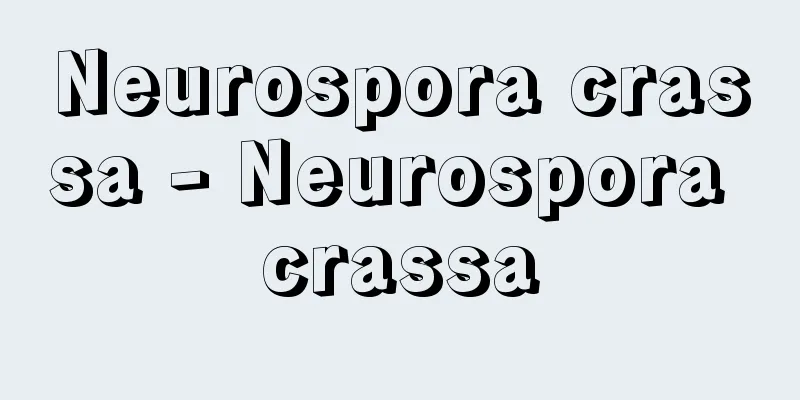Asteroid - Asteroid

|
In addition to the eight planets, there are countless small celestial bodies in the solar system. Among these small celestial bodies, those that do not have a halo of gas or dust around them are called asteroids. Asteroids are distributed widely throughout the solar system, but the majority of asteroids are found in a belt-like region between Mars and Jupiter, from 2.1 AU (astronomical units) to 3.3 AU. This area is called the asteroid belt. [Takanori Matsui] Observation historyThe existence of asteroids first became known to the public in the 19th century. The first asteroid, Ceres, was discovered on New Year's Day in 1801 by Piazzi of the Palermo Observatory in Sicily, Italy. Its position was equal to the position (~2.8 AU) predicted by the Titius-Bode law for an unknown planet. In March 1802, Olbers discovered the second asteroid, Pallas. Many other asteroids were subsequently discovered. In 1891, German astronomer M. Wolf began searching for asteroids using photography, and the rate of asteroid discovery increased dramatically. By June 1994, the orbits of asteroids had been determined, and up to asteroid number 6028 had been registered. [Takanori Matsui] Trajectory and distributionThe eccentricity and inclination of asteroids are generally larger than those of planets. The eccentricity ranges from about 0.1 to about 0.3, and the inclination of the orbital plane is up to about 30 degrees. Asteroids are not distributed uniformly in the asteroid belt. There are areas with fewer asteroids here and there. These are called the "Kirkwood Gap". This is because Jupiter orbits just outside the asteroid belt, and asteroids in orbits that are periodically affected by Jupiter's perturbation effect (orbits whose orbital period is an integer ratio to Jupiter's) are repelled from there. However, there are some asteroid groups whose orbits are stable despite this perturbation effect of Jupiter. For example, there is a "Hilda group asteroid" at 3.97 AU (an asteroid makes three revolutions in two revolutions of Jupiter). There is also a group of asteroids in Jupiter's orbit. These asteroids, called "Trojan asteroids," exist at positions 60 degrees in front of and behind the line connecting Jupiter and the Sun, forming the vertices of an equilateral triangle with Jupiter and the Sun. These points have been proven to be mechanically stable and are called Lagrangian points. Some asteroids located on the side of the asteroid belt closer to Mars have a large eccentricity and therefore penetrate inside the orbit of Mars. G. Shoemaker and others from the United States Geological Survey call these asteroids "Amor group asteroids" after the name of a representative asteroid. Asteroids that penetrate inside the Earth's orbit are also known. They are called "Apollo group asteroids." Most of them are small, about 1 km in diameter, but some are about 8 km. Apollo group asteroids are the solar system objects that come closest to the Earth, except for the Moon. Therefore, they are considered to be strong candidates for the parent bodies of meteorites. Many planetary scientists are considering choosing the Apollo group asteroids as targets for asteroid exploration. For this reason, detailed searches for Apollo group asteroids have begun. And every year, several new Apollo group asteroids with a diameter of 100 meters are discovered. There are also asteroids with semi-major axes smaller than Earth's. In 1976 Shoemaker and Helin classified these as "Aten asteroids". There are also asteroids beyond the orbit of Jupiter: Hidalgo (registered number 944) and Chiron (registered number 2060). These have orbits closer to those of comets than to asteroids. [Takanori Matsui] Family, size and number relationshipsWhen analyzing the orbital elements of asteroids, it is known that many asteroids can be divided into several groups with similar orbital elements. Each group is called a family. This was discovered in 1918 by Seiji Hirayama of Japan, and is named after him as the "Hirayama Family." Recent research has pointed out that the relative velocity distribution of asteroids belonging to the Hirayama Family is very similar to that of fragments of exploded artificial satellites. This suggests that the family (especially Themis, Eos, and Coronis) is composed of fragments resulting from impact destruction. There is a relationship between the size of asteroids and their number, such that the smaller the asteroid, the more numerous it is. If the diameter of an asteroid is D and the number of asteroids larger than D is N , this can be approximately expressed as N ∝ D -2 . This is the same as the size distribution of fragments seen when a rock is broken up, suggesting that asteroids are produced by breakup. [Takanori Matsui] Brightness and shapeIt is known that the brightness of many asteroids changes periodically. This is thought to be because the shape of the asteroid is not spherically symmetric but is flat. Another possible reason is that the brightness varies from hemisphere to hemisphere, but there are few examples of this. In the former case, the time between two periods of brightness change corresponds to the rotation period. The rotation periods of most asteroids measured so far range from 4 to 16 hours. The shape of most asteroids is not spherical, except for those with a diameter of 500 kilometers or more. This is thought to be because the smaller the celestial body, the less pressure there is at the center, and the more the body's strength can support the irregularities in the shape of its surface. [Takanori Matsui] Spectral distributionThe spectral distribution of reflectivity has been measured for over 500 asteroids. It has been found that the spectral distribution of asteroids can be correlated with that of various meteorites, allowing asteroids to be classified based on their spectral distribution. E-type asteroids resemble enstatite chondrites and have a high albedo (reflectivity) of over 23%. S-type and M-type asteroids have a lower albedo (7-23%) than E-type asteroids, similar to ordinary chondrites and stony-iron or iron meteorites, respectively. C-, P-, and D-type asteroids have a lower albedo (2-7%), with C-type asteroids resembling carbonaceous chondrites. No meteorites are known to correspond to the P- and D-type asteroids, but P-type asteroids are spectrally similar to M-type asteroids and have a lower albedo. D-type asteroids are dark and reddish, and are predicted to have a surface composition that may include organic matter. The orbital distributions of asteroids vary according to their spectral types. For example, types E and S have their peak distribution closer to Mars in the asteroid belt, while type C, the most common, is more prevalent closer to Jupiter. Several asteroids have been reported to have moons, but this has not been conclusively confirmed. [Takanori Matsui] originThere is no widely accepted hypothesis about the origin of asteroids. However, many planetary scientists believe that, when planets were formed through direct collisions of planetesimals, collisional destruction prevailed over amalgamation growth in the asteroid belt region for some reason. One of the reasons for this is that the mechanical properties of objects that are prone to collisional amalgamation, such as iron meteorites, change significantly near the asteroid belt. [Takanori Matsui] Located in the asteroid belt between Mars and Jupiter. Diameter 538 km. Photographed by the asteroid probe Dawn © NASA/JPL-Caltech/UCLA/MPS/DLR/IDA "> Vesta A near-Earth asteroid discovered in 1898, it is classified as an Amor group asteroid. It is about 35 km long. The photo is a composite of six images taken by the asteroid probe "Nia". ©NASA/JPL/JHUAPL "> Eros An asteroid discovered in September 1998. It is one of the near-Earth asteroids and is classified as an Apollo group asteroid. Its longest point is about 540m. It is an S-type asteroid composed mainly of iron and magnesium. Photographed by the asteroid probe "Hayabusa" ©JAXA "> Itokawa It is one of the near-Earth asteroids and is classified as an Apollo asteroid. It is about 900m in size. It is a C-type asteroid made of carbonaceous chondrite. Photographed from an altitude of 22km by the asteroid probe "Hayabusa 2" ©ONC team (JAXA, University of Tokyo, Kochi University, Rikkyo University, Nagoya University, Chiba Institute of Technology, Meiji University, University of Aizu, National Institute of Advanced Industrial Science and Technology) Ryugu Source: Shogakukan Encyclopedia Nipponica About Encyclopedia Nipponica Information | Legend |
|
太陽系には八つの惑星以外にサイズの小さな天体が無数に存在する。そうした小天体のうち、周りにガスや塵(ちり)からなるハローをもたないものを小惑星という。小惑星の存在する領域は太陽系内に広く分布しているが、とくに火星と木星の間、2.1AU(天文単位)から3.3AUの帯状の領域に大多数の小惑星が存在する。その部分を小惑星帯とよぶ。 [松井孝典] 観測史小惑星の存在が初めて世に知られたのは19世紀に入ってからである。1801年の元旦(がんたん)、イタリア、シチリア島パレルモ天文台のピアッツィによって最初の小惑星ケレスが発見された。それはティティウス‐ボーデの法則の予想する未知の惑星の位置(~2.8AU)に等しかった。1802年3月にはオルバースが第二の小惑星パラスを発見した。その後、引き続いて多くの小惑星が発見された。 1891年からはドイツの天文学者M・ウォルフによって写真を用いた小惑星の捜索が開始され、小惑星の発見率は飛躍的に高くなった。1994年6月までに軌道が確定し、登録された小惑星は6028番まである。 [松井孝典] 軌道と分布小惑星の離心率や軌道面傾斜角は惑星のそれに比べると一般的に大きい。離心率は0.1ぐらいから0.3ぐらいに分布し、軌道面傾斜角は30度ぐらいまで傾いている。小惑星帯には一様に小惑星が存在するわけではない。ところどころ小惑星の個数の少なくなっている領域が存在する。それを「カークウッドの空隙(くうげき)」とよぶ。これは、小惑星帯のすぐ外側を木星が運行しているため、木星の摂動(せつどう)効果を周期的に受ける軌道(木星の公転周期とその公転周期が整数比になる軌道)上の小惑星はそこからはじき飛ばされることによる。しかし、なかにはこうした木星の摂動効果にもかかわらずその軌道が安定な小惑星群も存在する。たとえば3.97AU(木星2公転間に小惑星は3公転する)には「ヒルダ群小惑星」が存在する。木星軌道上にも一群の小惑星が存在する。「トロヤ群小惑星」とよばれるこれらの小惑星は、木星と太陽を結ぶ線に対しその前後に60度離れた、ちょうど木星、太陽と正三角形の頂点をなす位置に存在している。そこは力学的に安定なことが証明されており、ラグランジュ点とよばれる。 小惑星帯の火星に近い側に位置する小惑星のなかには、その離心率が大きいため火星軌道の内側にまで入り込むものがある。アメリカ地質調査所のG・シューメーカーらはこうした小惑星群のことを、その代表的な小惑星の名をとって「アモール群小惑星」とよんでいる。地球軌道の内側にまで入り込む小惑星も知られている。それらは「アポロ群小惑星」とよばれる。ほとんどのものが小さく、直径1キロメートルぐらいであるが、なかには8キロメートルぐらいのものもある。アポロ群小惑星は、月を除くと、もっとも地球に接近する太陽系天体である。そのため隕石(いんせき)の母天体の有力な候補であると考えられている。小惑星探査の標的天体をアポロ群小惑星のなかから選ぼうと考えている惑星科学者も多い。そのためアポロ群小惑星の詳しい捜索が開始されている。そして毎年、新たに100メートルサイズのアポロ群小惑星が数個ずつ発見されている。 軌道長半径が地球より小さな小惑星群も存在する。1976年シューメーカーとヘリンはこれらを「アテン群小惑星」と分類した。木星軌道より外側にも小惑星が存在する。登録番号944のヒダルゴと2060のチロンである。これらは小惑星より彗星(すいせい)に近い軌道をもつ。 [松井孝典] 族・大きさと個数の関係小惑星の軌道要素を分析すると、多くの小惑星が似たような軌道要素をもついくつかのグループに分けられることが知られている。各グループのことを族とよぶ。このことは1918年に日本の平山清次(せいじ)によって発見されたため、その名にちなんで「ヒラヤマ・ファミリー」とよばれる。近年の研究によると、ヒラヤマ・ファミリーに属する小惑星の相対速度分布は爆発した人工衛星の破片のそれによく似ていることが指摘されている。このことは、族(とくにテミス、エオス、コロニス)が衝突破壊によって生じた破片から構成されていることを示唆している。 小惑星の大きさと個数との間には、小さいものほどその個数が多くなるという関係がある。小惑星の直径をDとし、Dより大きい小惑星の個数をNとすると近似的にN∝D-2と表すことができる。これは岩石を破壊したときにみられる破片のサイズ分布と同じで、小惑星が破壊によって生じたことを示唆している。 [松井孝典] 明るさと形状多くの小惑星はその明るさが周期的に変化することが知られている。その理由は、小惑星の形が球対称でなく扁平であるためと考えられている。それ以外の理由としては半球ごとに明るさが異なるためとも考えられるが、そうした例は少ない。前者の場合、明るさの変化の2周期間の時間が自転周期に相当する。これまでに測定された小惑星の自転周期はそのほとんどが4~16時間の間に分布する。小惑星の形状は直径が500キロメートル以上のものを除くとほとんどのものが球から外れている。その理由は、小天体ほど天体中心での圧力が小さく、表面の形状のいびつさを自身の強度で支えることが可能なためと考えられている。 [松井孝典] スペクトル分布500個以上の小惑星に対して反射能のスペクトル分布が測定されている。それによると小惑星のスペクトル分布は各種の隕石(いんせき)のそれと対応づけられ、小惑星をそのスペクトル分布に基づいて分類することができる。E型はエンスタタイトコンドライトに似ていて、アルベド(反射能)も23%以上と高い。S型、M型はE型に比べるとアルベドが7~23%と低く、前者が普通コンドライト、後者が石鉄あるいは鉄隕石と似ている。C、P、D型はアルベドが2~7%と低く、C型は炭素質コンドライトに似ている。P、D型に対応する隕石は知られていないが、P型はスペクトルとしてはM型に似ていて、アルベドがより低い。D型は暗くて赤みがかり、有機物を含む表面の組成をもつのではないかと予想されている。スペクトル型に対応して軌道分布も異なる。たとえば、E型やS型は小惑星帯の火星寄りに分布のピークをもつのに対し、もっとも数の多いC型は木星寄りに多く分布する。 いくつかの小惑星は衛星をもつことが報告されている。しかしこのことは最終的に確認されたわけではない。 [松井孝典] 起源小惑星の起源については、まだ一般に広く認められている仮説は存在しない。しかし、微惑星の直接衝突を通じて惑星が形成される際、なんらかの理由で小惑星帯領域では合体成長よりも衝突破壊が卓越しておこったと、多くの惑星科学者は考えている。その理由の一つとして、鉄隕石のような衝突合体しやすいものの力学的性質が小惑星帯付近で大きく変化することがあげられている。 [松井孝典] 火星と木星の間の小惑星帯に位置する。直径538km。小惑星探査機「ドーン」により撮影©NASA/JPL-Caltech/UCLA/MPS/DLR/IDA"> ベスタ 1898年に発見された地球近傍小惑星で、アモール群に分類される。長さ約35km。写真は、小惑星探査機「ニア」が撮影した6枚の画像を組み合わせたもの©NASA/JPL/JHUAPL"> エロス 1998年9月に発見された小惑星。地球近傍小惑星の一つで、アポロ群に分類される。最長部約540m。鉄やマグネシウムを主成分とするS型小惑星である。小惑星探査機「はやぶさ」により撮影©JAXA"> イトカワ 地球近傍小惑星の一つで、アポロ群に分類される。大きさは約900m。炭素質コンドライトからなるC型小惑星である。小惑星探査機「はやぶさ2」により高度22kmから撮影©ONCチーム(JAXA 東京大学 高知大学 立教大学 名古屋大学 千葉工科大学 明治大学 会津大学 産業技術総合研究所)"> リュウグウ 出典 小学館 日本大百科全書(ニッポニカ)日本大百科全書(ニッポニカ)について 情報 | 凡例 |
Recommend
Betti, E. (English spelling) BettiE
...With regard to curves, Jordan's theorem wa...
Oproschenie - Oproschenie
...Beginning in 1879, Confession (published in Ge...
Aeolian, eolian
A term used when sediments are concentrated by win...
Nadachi [town] - Nadachi
A former town in Nishikubiki County, southwest of ...
Kyushu Expressway - Kyushu Expressway
An expressway that runs north to south through Ky...
Abelia spathulata (English spelling) Abelia spathulata
…[Makoto Fukuoka] [Makoto Wakisaka]. … *Some of t...
Thiothrix
…They are found in seawater, marine mud, fresh wa...
Kanoiwa
...In particular, the old Yamanashimura area in t...
Bacon, N. (English spelling)
…A peasant revolt that occurred in the Virginia c...
Kale - Kale (English spelling)
A perennial plant of the Brassicaceae family (APG...
Great Bowerbird - Great Bowerbird
...The female lays eggs in a nest located at a di...
Chain store
This type of retail format emerged in the United S...
Scratch - Scratch
1. The area where the skin or muscle has been torn...
Competition Law
… It is natural that economic laws that embody th...
Convention for the protection of fur seals
… [background] Because their fur is high quality ...



![Kurobe [city] - Kurobe](/upload/images/67cb740ed39fa.webp)





